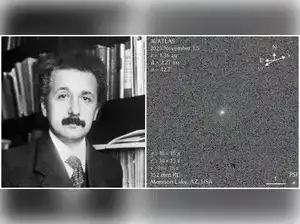The mysterious interstellar object 3I/ATLAS has stunned astronomers, seemingly confirming one of Albert Einstein’s most famous predictions over a century after it was proposed. As the object reached its closest approach to the Sun, scientists observed that the star’s gravity bent the light coming from the object, a phenomenon known as gravitational lensing, predicted by Einstein in his 1915 theory of general relativity.
Also Read: 3I/ATLAS: Trump-fav US lawmaker presses NASA for answers on ‘interstellar visitor’ comet 3I/ATLAS, urges public release of images
According to reports and explanations by Harvard professor Avi Loeb, one of the few commentators who have pointed out the major anomaly of the object, 3I/ATLAS showed a shift in its apparent position in the sky of about four arcseconds. Means it exceeds the 0.27 arcseconds that scientists initially predicted. For reference, one arcsecond is 1/3600 of a degree, equivalent to viewing a dime from 2.5 miles away.
Also Read: What happens if we nuke 3I/ATLAS? Why scientists say deflection, not destruction, is the key to safely steering comets away from Earth
Also Read: Christmas gift from 3I/ATLAS? Harvard’s Avi Loeb predicts ‘mini-probes’ from ‘alien mothership’ could reach earth a week before Christmas
This would have created a massive visible cloud of gas and dust, Loeb explained in his latest Medium blog. “If there’s no such cloud, it could suggest that 3I/ATLAS is not a natural object,” quotes Daily Mail.
Loeb also highlighted the unusual brightening and color change of the object near perihelion on October 29, noting that it appeared bluer than the Sun, while normal comets tend to appear red as they absorb and reflect sunlight differently.
Also Read: 3I/ATLAS: Trump-fav US lawmaker presses NASA for answers on ‘interstellar visitor’ comet 3I/ATLAS, urges public release of images
According to reports and explanations by Harvard professor Avi Loeb, one of the few commentators who have pointed out the major anomaly of the object, 3I/ATLAS showed a shift in its apparent position in the sky of about four arcseconds. Means it exceeds the 0.27 arcseconds that scientists initially predicted. For reference, one arcsecond is 1/3600 of a degree, equivalent to viewing a dime from 2.5 miles away.
What was Einstein’s prediction?
Einstein’s theory of general relativity states that massive objects like the Sun warp the fabric of space-time, causing light to bend around them. This effect, gravitational lensing, has been observed before around stars and galaxies, but 3I/ATLAS provided a rare opportunity to see it applied to a moving interstellar visitor within our solar system.Also Read: What happens if we nuke 3I/ATLAS? Why scientists say deflection, not destruction, is the key to safely steering comets away from Earth
So how does the 3I/ATLAS prove Einstein’s theory and raise more questions?
In simple words, as 3I/ATLAS passed close to the sun, the sun’s gravity bent the light coming from the object, causing its position to shift slightly in the sky, an effect that matched Einstein’s predictions. However, 3I/ATLAS’s actual shift was even greater than expected, straying four arcseconds off its predicted path. This large deviation led to more questions about the nature and origin of 3I/ATLAS.Is 3I/ATLAS really a comet?
Harvard astrophysicist Avi Loeb has been among the most vocal scientists pointing out unusual behaviors of 3I/ATLAS. He noted that for the object to be a conventional comet, it would have had to eject roughly 15 percent of its mass as gas during its closest approach to the Sun, about five billion tons, to explain its unexpected path.Also Read: Christmas gift from 3I/ATLAS? Harvard’s Avi Loeb predicts ‘mini-probes’ from ‘alien mothership’ could reach earth a week before Christmas
This would have created a massive visible cloud of gas and dust, Loeb explained in his latest Medium blog. “If there’s no such cloud, it could suggest that 3I/ATLAS is not a natural object,” quotes Daily Mail.
Loeb also highlighted the unusual brightening and color change of the object near perihelion on October 29, noting that it appeared bluer than the Sun, while normal comets tend to appear red as they absorb and reflect sunlight differently.




